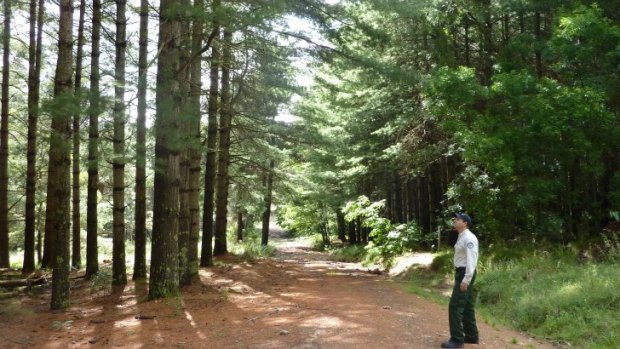
Bendora Arboretum - a survivor of the 2003 Canberra bushfiresCredit: Tim the Yowie Man
The 2003 fires devastated 70 per cent of the ACT, including much of the hills and valleys to our city's west. However, 10 years on, and following a couple of wet seasons, the bush is bouncing back.
While well-known recreation precincts, such as Cotter Reserve and Tidbinbilla Nature Reserve, have since been revamped, ?other areas remain something of a secret to virtually a whole generation of Canberrans.
You could spend every day for a whole year exploring the ridges, gorges, mountain peaks and rivers to our west and still not see it all. Today, I share my top three places to venture beyond Cotter and Tidbinbilla into our regenerating mountain country. You never know what you might find.
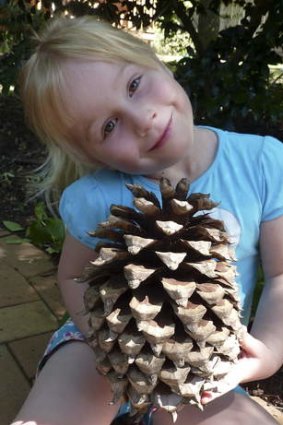
One of Bendora Arboretum's big pine cones.Credit: Tim the Yowie Man
1. Land of the giants
Among the tallest trees growing in our mountains are Alpine Ash (Euca-lyptus delegatensis). Unlike many other eucalypts, which if burnt can regenerate from epicormic buds situated deep in their thick bark, fire kills Alpine Ash as they can only regenerate from seed. On the higher peaks of the Brindabellas, poking like giant totem poles above their regenerating offspring, are countless stands of Alpine Ash, all victims of the 2003 firestorm.
However, some of the most impressive trees in our mountains aren't native at all. In the middle of last century, 34 arboreta were established in the ACT primarily ?to discover more about which species were potentially suitable for forest plantations in Australia. After the 2003 bushfires, the Bendora Arboretum was the only upland arboretum left standing.
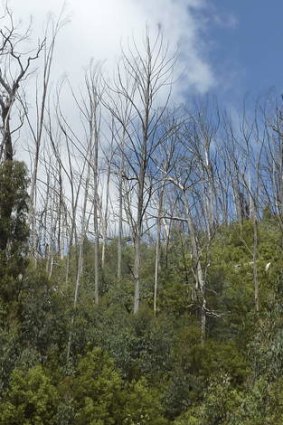
Fire-ravaged alpine ash in the Brindabellas still tower over their offspring growing below.Credit: Tim the Yowie Man
Most of the 52 different species planted here are conifers, larches, spruces, firs and white pines, and by 1974, foresters had determined that the Monterey pine (Pinus radiata) was the best species for most sites in cool, temperate southern Australia.
However, this hidden treasure trove of trees is also home to a small stand of the aptly named Big Cone Pine (Pinus coulteri), which produces the biggest (and heaviest) pine cones in the world. These monster cones can grow as big as footballs and are fortified with sharp talons on the end of each scale. If you see one falling, run.
The Bendora Arboretum also features several mature sugar pines (Pinus lambertiana) that are native to north-west Mexico and western US and bear the world's longest pine cones.
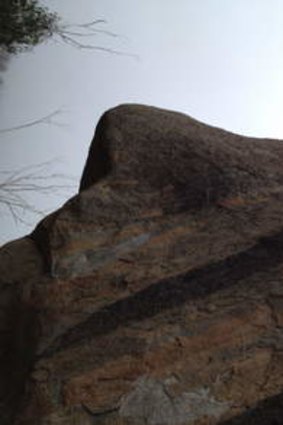
A stone guardian near Orroral Hill in Namadgi national park.Credit: John Evans
Want to go Bendora Arboretum is about a one-hour drive (partly on a gravel road) from most parts of Canberra. Access requires a 1.5-kilometre walk along Chalet Road from a locked gate near its junction with Mount Franklin Road. Allow an hour or so to stroll among the towering pines and other exotic species. Copies of an information sheet on the arboretum and a visitors' book are kept in the adjacent Bendora Hut.
2. Faces of nature
Do you ever get the feeling when walking alone in the bush that someone is following you While it could be another bushwalker, it's more than likely just the bush, in all its guises, keeping an eye on you.
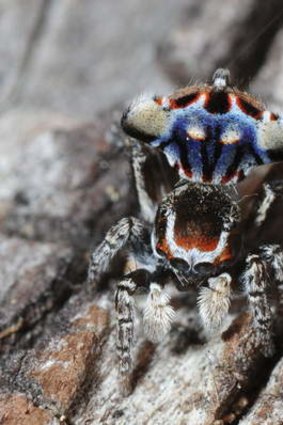
Harris' Peacock Spider.Credit: Stuart Harris
Across the peaks of Namadgi National Park and the granite-strewn Tidbinbilla and Brindabella ranges are many "faces" and "forms" in nature, some of which have featured in this column's semi-regular "Simulacra Corner".
Some simulacra are the results of thousands of years of exposure to the elements, while others are created in the twinkle of an eye, such as when a branch falls off a tree and lands in a certain way on the ground.
Just as fire can destroy some simulacra (such as burning trees and causing rocks to explode), it can also create new ones by triggering regrowth and exposing rocks previously hidden under thick vegetation.
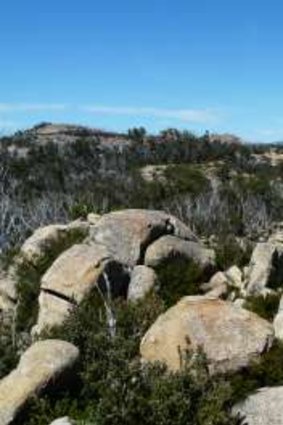
View from Booroomba RocksCredit: Tim the Yowie Man
Rocks that resemble human or animal faces are the most common form of simulacra in our mountain country, the best of which include a giant face near Bendora Dam and this stone guardian near Orroral Hill in Namadgi National Park.
Want to go? Your imagination is the only limit. You might find some on the side of the road or others hidden deep in a rarely explored valley. If you find one, don't forget to send it to my Simulacra Corner.
3. All creatures great and small
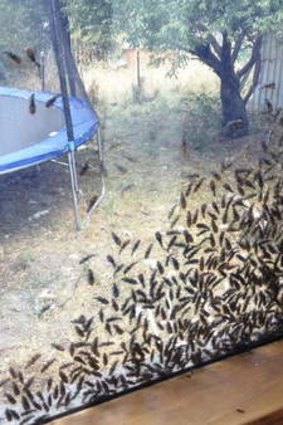
Soldier beetles swarm in Kambah.Credit: Sharyn Payne
Like most swathes of bush, the ACT high country is home to a wide range of wildlife. While some species haven't been sighted for decades, such as the rare and shy native smoky mouse (Pseudo-mys fumeus), others, such as the northern corroboree frog (Pseudoph-ryne pengilleyi) are hanging on to survival by a mere thread. And who knows how many more species lie in wet gullies or shelter on windswept peaks still waiting to be discovered.
The most recent species unearthed in the ACT was discovered by Canberra vineyard worker Stuart Harris while walking at Booroomba Rocks in 2008. Stuart was experimenting with a new macro lens for his camera and liked "the contrast between the foliage and brightly coloured markings of a spider".
After his walk, he posted his images on a photo-sharing website to see if anyone might be able to identify the unusual spider. An expert from the US noticed his photo and suggested it might be a new species of peacock spider – so named because of the male's courtship display. When a female approaches, the male raises its abdomen vertically. Side flaps pop out and are displayed like a peacock's tail.
Encouraged by the prospect of discovering a new species, Stuart spent 150 hours over two years searching for a live specimen. In October 2011, he finally found a specimen, which was subsequently described by scientists as a new species. In honour of Stuart's efforts, the spider was named Harris' Peacock Spider (Maratus harrisi).
Want to go? Booroomba Rocks is about an hour's drive from Civic. Drive south of Tharwa into the Namadgi National Park. Turn right on to Apollo Road. Follow this sealed road for about 9 kilometres then turn right on to an unsealed road (2WD accessible). Follow this road for about 3 kilometres? until you reach the car park, where there's a 2.5-kilometre return walking track to a lookout at the top of the rocks. I can't guarantee you'll discover a new species, but if the weather is fine, you'll get sweeping views of Canberra's southern suburbs.
Fact File:
Past Present Future: Until 18 February, Scope Mount Stromlo is hosting an exhibition that commemorates the destruction, recovery and renewal of fire affected areas from 2003 until the present day. Where? Scope Mount Stromlo, Mount Stromlo Road Weston Creek.10am – 5pm Tuesday – Sunday. This is an organic exhibition and as such community groups & individuals are welcome to add to the exhibits space with personal or group expressions at any time by contacting Scope Director, Simone Hunter on 6162 2388 centenary@scopemountstromlo.com.au
SPOTTED
This week, Sharyn Payne was shocked to notice hundreds of insects crawling over her deck and windows, describing the scene in a frantic tweet as "apocalyptic". The culprits are Plague Soldier Beetles (Chauliognathus lugub-ris) and Payne's deck isn't the only place where they are in huge numbers. A spokesperson for the Australian National Botanic Gardens, where they can also currently be seen in large numbers, says "the beetles swarm during the mating period, sometimes in such large numbers, they weigh down the branches of some plants".
CONTACT TIM
Email: timtheyowieman@bigpond.com or Twitter: @TimYowie, or write to me c/o The Canberra Times, 9 Pirie St, Fyshwick.
Sign up for the Traveller newsletter
The latest travel news, tips and inspiration delivered to your inbox. Sign up now.